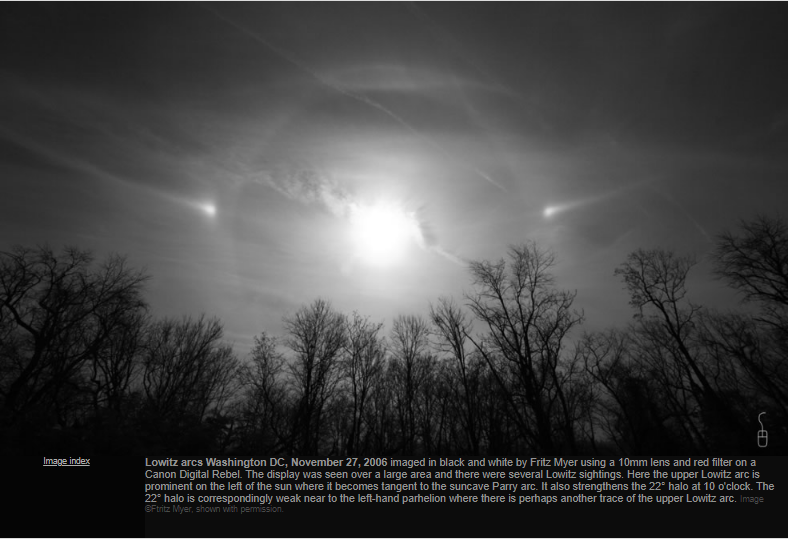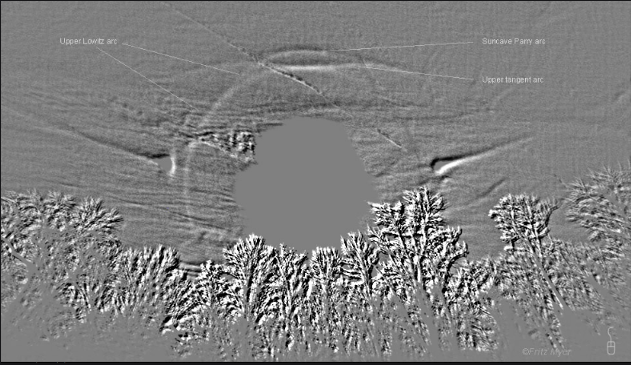Lowitz arcs - Washington DC
Lowitz Arcs - Washington DC: A Captivating Atmospheric Optics Phenomenon
Atmospheric optics never cease to amaze us with their stunning displays of light and color. One such captivating phenomenon is the Lowitz arcs, which were observed in Washington DC on November 27, 2006. The event left spectators in awe as they witnessed the beauty of these arcs that added an enchanting touch to the sky.
The Lowitz arcs observed in Washington DC were expertly captured by Fritz Myer, using a 10mm lens and a red filter on a Canon Digital Rebel camera. The resulting black and white images showcased the intricate details of this atmospheric optical phenomenon. It is worth noting that the display was not limited to a small area but rather spanned a large region, allowing for multiple sightings of the Lowitz arcs.
In the images captured by Fritz Myer, the upper Lowitz arc stands out prominently on the left side of the sun, where it becomes tangent to the suncave Parry arc. This interaction between the Lowitz arc and the suncave Parry arc creates a visually striking effect. Additionally, the presence of the upper Lowitz arc strengthens the appearance of the 22° halo at 10 o'clock. However, it is fascinating to observe that the 22° halo is relatively weaker near the left-hand parhelion, suggesting the possibility of another trace of the upper Lowitz arc in that area.
The Lowitz arcs, named after German meteorologist Carl Löwitz, are a rare and complex atmospheric optical phenomenon. They are classified as circumzenithal arcs, which means they form a circle around the zenith, or the point directly above an observer's head. These arcs are created by sunlight interacting with ice crystals in cirrus clouds or with diamond dust particles in very cold temperatures. The unique geometry and alignment of these ice crystals or diamond dust particles play a crucial role in the formation of the Lowitz arcs.
While circumzenithal arcs are relatively common, the Lowitz arcs are less frequently observed due to their specific conditions and geometrical requirements. To witness these arcs, one needs a combination of factors, including the presence of cirrus clouds or diamond dust particles, the proper alignment of the crystals or particles, and the position of the observer relative to the light source. These factors must align perfectly to create the mesmerizing display of the Lowitz arcs.
The Lowitz arcs typically appear as bright, colorful arcs located above the 22° halo. They exhibit vibrant hues, ranging from red on the inner side to blue on the outer side. This color gradient is caused by the refraction and dispersion of sunlight as it passes through the ice crystals or diamond dust particles. The unique optical properties of these particles cause different wavelengths of light to bend at varying angles, resulting in the separation of colors and the creation of this captivating color spectrum.
It is important to note that atmospheric optics phenomena like the Lowitz arcs are transient and fleeting in nature. They appear for a brief period and then vanish, making their observation even more special. Capturing these moments through photography allows us to preserve and appreciate the beauty of these natural wonders long after they have disappeared from the sky.
In conclusion, the Lowitz arcs observed in Washington DC on November 27, 2006, provided a breathtaking display of atmospheric optics. These arcs added a touch of magic to the sky, with their unique interaction with other optical phenomena such as the suncave Parry arc and the 22° halo. Understanding the scientific principles behind their formation enhances our appreciation for these elusive and captivating displays. The beauty of atmospheric optics lies in their ability to surprise and mesmerize us, reminding us of the wonders that exist right above our heads.


Lowitz arcs Washington DC, November 27, 2006 imaged in black and white by Fritz Myer using a 10mm lens and red filter on a Canon Digital Rebel. The display was seen over a large area and there were several Lowitz sightings. Here the upper Lowitz arc is prominent on the left of the sun where it becomes tangent to the suncave Parry arc. It also strengthens the 22° halo at 10 o'clock. The 22° halo is correspondingly weak near to the left-hand parhelion where there is perhaps another trace of the upper Lowitz arc.
Image ©Ftritz Myer, shown with permission.
Note: this article has been automatically converted from the old site and may not appear as intended. You can find the original article here.
Reference Atmospheric Optics
If you use any of the definitions, information, or data presented on Atmospheric Optics, please copy the link or reference below to properly credit us as the reference source. Thank you!
-
<a href="https://atoptics.co.uk/blog/lowitz-arcs-washington-dc/">Lowitz arcs - Washington DC</a>
-
"Lowitz arcs - Washington DC". Atmospheric Optics. Accessed on November 26, 2024. https://atoptics.co.uk/blog/lowitz-arcs-washington-dc/.
-
"Lowitz arcs - Washington DC". Atmospheric Optics, https://atoptics.co.uk/blog/lowitz-arcs-washington-dc/. Accessed 26 November, 2024
-
Lowitz arcs - Washington DC. Atmospheric Optics. Retrieved from https://atoptics.co.uk/blog/lowitz-arcs-washington-dc/.